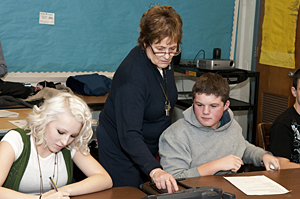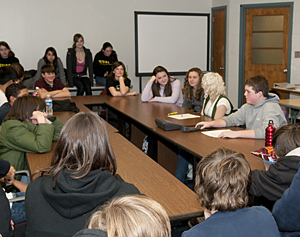

ADVERTISEMENT
- Rozovsky wins prestigious NSF Early Career Award
- UD students meet alumni, experience 'closing bell' at NYSE
- Newark Police seek assistance in identifying suspects in robbery
- Rivlin says bipartisan budget action, stronger budget rules key to reversing debt
- Stink bugs shouldn't pose problem until late summer
- Gao to honor Placido Domingo in Washington performance
- Adopt-A-Highway project keeps Lewes road clean
- WVUD's Radiothon fundraiser runs April 1-10
- W.D. Snodgrass Symposium to honor Pulitzer winner
- New guide helps cancer patients manage symptoms
- UD in the News, March 25, 2011
- For the Record, March 25, 2011
- Public opinion expert discusses world views of U.S. in Global Agenda series
- Congressional delegation, dean laud Center for Community Research and Service program
- Center for Political Communication sets symposium on politics, entertainment
- Students work to raise funds, awareness of domestic violence
- Equestrian team wins regional championship in Western riding
- Markell, Harker stress importance of agriculture to Delaware's economy
- Carol A. Ammon MBA Case Competition winners announced
- Prof presents blood-clotting studies at Gordon Research Conference
- Sexual Assault Awareness Month events, programs announced
- Stay connected with Sea Grant, CEOE e-newsletter
- A message to UD regarding the tragedy in Japan
- More News >>
- March 31-May 14: REP stages Neil Simon's 'The Good Doctor'
- April 2: Newark plans annual 'wine and dine'
- April 5: Expert perspective on U.S. health care
- April 5: Comedian Ace Guillen to visit Scrounge
- April 6, May 4: School of Nursing sponsors research lecture series
- April 6-May 4: Confucius Institute presents Chinese Film Series on Wednesdays
- April 6: IPCC's Pachauri to discuss sustainable development in DENIN Dialogue Series
- April 7: 'WVUDstock' radiothon concert announced
- April 8: English Language Institute presents 'Arts in Translation'
- April 9: Green and Healthy Living Expo planned at The Bob
- April 9: Center for Political Communication to host Onion editor
- April 10: Alumni Easter Egg-stravaganza planned
- April 11: CDS session to focus on visual assistive technologies
- April 12: T.J. Stiles to speak at UDLA annual dinner
- April 15, 16: Annual UD push lawnmower tune-up scheduled
- April 15, 16: Master Players series presents iMusic 4, China Magpie
- April 15, 16: Delaware Symphony, UD chorus to perform Mahler work
- April 18: Former NFL Coach Bill Cowher featured in UD Speaks
- April 21-24: Sesame Street Live brings Elmo and friends to The Bob
- April 30: Save the date for Ag Day 2011 at UD
- April 30: Symposium to consider 'Frontiers at the Chemistry-Biology Interface'
- April 30-May 1: Relay for Life set at Delaware Field House
- May 4: Delaware Membrane Protein Symposium announced
- May 5: Northwestern University's Leon Keer to deliver Kerr lecture
- May 7: Women's volleyball team to host second annual Spring Fling
- Through May 3: SPPA announces speakers for 10th annual lecture series
- Through May 4: Global Agenda sees U.S. through others' eyes; World Bank president to speak
- Through May 4: 'Research on Race, Ethnicity, Culture' topic of series
- Through May 9: Black American Studies announces lecture series
- Through May 11: 'Challenges in Jewish Culture' lecture series announced
- Through May 11: Area Studies research featured in speaker series
- Through June 5: 'Andy Warhol: Behind the Camera' on view in Old College Gallery
- Through July 15: 'Bodyscapes' on view at Mechanical Hall Gallery
- More What's Happening >>
- UD calendar >>
- Middle States evaluation team on campus April 5
- Phipps named HR Liaison of the Quarter
- Senior wins iPad for participating in assessment study
- April 19: Procurement Services schedules information sessions
- UD Bookstore announces spring break hours
- HealthyU Wellness Program encourages employees to 'Step into Spring'
- April 8-29: Faculty roundtable series considers student engagement
- GRE is changing; learn more at April 15 info session
- April 30: UD Evening with Blue Rocks set for employees
- Morris Library to be open 24/7 during final exams
- More Campus FYI >>
1:58 p.m., Dec. 17, 2009----While Santa was busy at the North Pole getting ready for Christmas Eve, University of Delaware researchers at the South Pole recently found time to connect with school students of all ages in the First State.
More than 500 students in elementary, middle, and high schools across the state participated in a “Phone Call to the Deep Freeze,” held Wednesday, Dec. 16, as part of the UD pilot program, “Extreme 2009: An Antarctic Adventure.”
Among the participants were about 30 ninth-grade students in an earth science environmental management class at Newark High School taught by Patricia Barnthouse.
The students are members of the Cambridge Program implemented at Newark High School four years ago to meet the needs of academically gifted students interested in a college preparatory program that combines rigorous coursework and independent research.
Having joined students from eight classrooms across the state, the Cambridge Program participants had prepared two questions for researchers when the call from the South Pole came through.
“Good afternoon, Delaware. Welcome to your Antarctic phone call,” said James Roth, senior electronics instrument specialist from UD. “It's 7:38 a.m. here, and it's Dec. 17, and most of us are just coming from breakfast.”
Also speaking to the students from Antarctica were Chris Elliot, senior electronics instrument specialist, and Serap Tilav, a scientist in the UD Department of Physics and Astronomy. The call also linked participants with Thomas Gaisser, Martin A. Pomerantz Professor of Physics and Astronomy at UD, who spoke from Germany, where he is on a Humboldt Research Fellowship.
Other classes participating in the South Pole scientific conference call included fourth- and eighth-grade students from Brandywine Springs Elementary School, and sixth- and eighth-grade students at Corpus Christi School, both in Wilmington, as well as students from Milford Senior High School, Mt. Pleasant High School, Seaford High School and Wilmington Friends School.
Nathan Harlan presented the first question from the Newark High Cambridge Program group, asking Roth if anyone has ever fallen down any of the mile-and-a-half-deep holes that comprise IceCube, the world's largest neutrino telescope being built in the Antarctic ice. The UD research team at the South Pole also is constructing the telescope's surface array of detectors called “IceTop.”
“We take safety very seriously with IceCube,” Roth said. “We have an excellent program dealing with things that lead up to any situation that might cause somebody to be hurt.”
To help insure safety around the 52-inch diameter holes, Roth said holes are covered and there is an implicit rule that “you don't turn your back on the hole.”
Additional safety measures include the right of researchers to stop working whenever they feel it is necessary. Backup safety measures also include mountain climbing gear and what Roth described as a “very impressive medical capability.”
“Our main purpose is not to let anybody go down the hole,” Roth said. “It's all business out there, and we do take safety very seriously.”
The second research question, which at first brought on a bit of laughter from researchers and students, was “Do animals, such as penguins or Yetis live at the South Pole, and do you pet them?”
While Roth reassured students that there are no animals that can survive in the environment where temperatures regularly hover around 40 degrees below zero with the wind chill, he joked that some researchers may resemble Yetis because of a policy that permits only a pair of two-minute showers per week.
“Once in a great while a seagull might make it to the South Pole, but they are not able to make it back to where they came from,” Roth said. “Because of an international treaty that protects them, animals that do exist in certain parts of Antarctica do not see us as enemies. So we don't do anything that affects the wildlife. We don't do anything to violate that treaty.”
While Gaisser and Roth fielded questions dealing with neutrino research, including how much headway has been made in investigating anti-matter and dark matter, they also reminded students that scientific research at the South Pole is a 12 hour per day, six day per week effort that goes on regardless of the weather or the season.
When one of the researchers replied that he had not spent Christmas at home for the last six years, a moment of silence at both ends of the phone connection emphasized the emotions stirred up by the remark.
“The part about not being home for the last six Christmases really got to me,” student Dana Clem said. “It's really something to make you think about what these people go through.”
Ben Mazur described the program as being “pretty interesting,” adding, “I enjoyed hearing about the physics behind the neutrinos and how this could help us understand more about the universe.”
“It was a once in a lifetime experience,” Harlan said. “I was really glad that I got to be the speaker for our group. This also got me interested in the science programs at the University of Delaware.”
Jimmy Van Cleaf noted that participating in the Deep Freeze phone call was a rare and enriching experience. “I enjoyed hearing about their daily life down there. It's nice to hear that they have some activities they can enjoy when they are not working.”
Brenda Khan said she was very impressed by the questions submitted by the fourth-grade class at Brandywine Springs School. “I think this will help me academically. I now have a wider amount of information on science.”
Diana Advani said that she liked a question about how there are rainbows in a land where it does not rain -- there rainbows are called halos or “sun dogs” -- and also learning about environmental science in connection with the UD research efforts.
Greg Barrier thought the program was enlightening, including the part about how the food for the research teams was flown to Antarctica and about how the territory is split into east and west regions that are separated by the Transantarctic Mountains.
Raul Barva said “hearing about the research they are doing in Antarctica gives me a chance to find out more about the topic. I'm interested in international affairs, and I find it encouraging that all of the countries that are involved have found a way to cooperate with each other down there.”
Bethany Beahler found it interesting to hear about the nearly two-mile-deep ice in which the UD researchers are building the neutrino telescope as part of an international collaboration and the amount of energy consumed in this project.
Tom Kalas said that participating in the phone call from the South Pole was probably the closest he will get to Antarctica, and he also was impressed by the questions submitted by the fourth grade class at Brandywine Springs.
Listening to the remarks of her students also was rewarding for Barnthouse, who said, “I was just thrilled to have the kids participate. I find it fascinating and it's great to see that there is such an interest about science among these students.”
Article by Jerry Rhodes
Photos by Doug Baker


